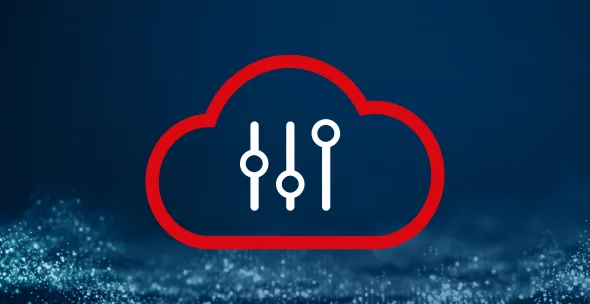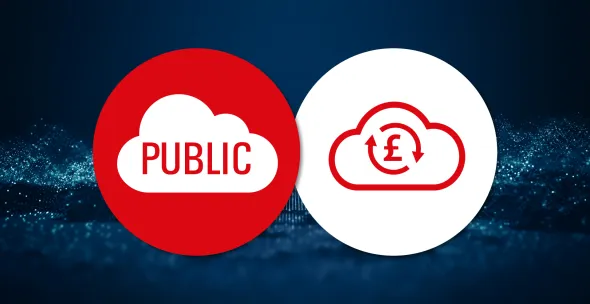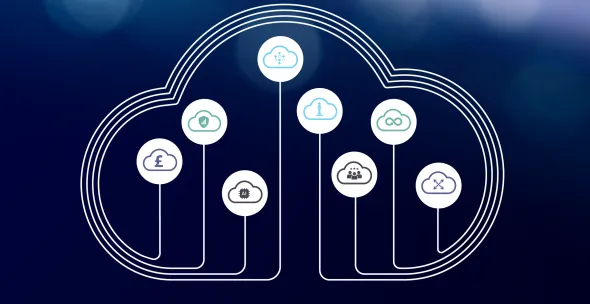Cloud-first, hybrid or on-prem? What’s right for your business?

Don Morris
Cloud Delivery Architect (Azure)
Where should you store and process your organisation’s data? Let’s not pretend that every organisation starts with a blank piece of paper and no preconceptions about their infrastructure and storage needs. Most companies we work with ask this question because their current approach isn’t working. Maybe their business and technological needs have changed as their business evolved, because their business has grown rapidly but organically, or because their infrastructure can no longer handle the workload.
In this blog, we explain why choosing your approach to data storage and infrastructure needs to start with the question of why. Or, more specifically, what is the business case?
The perils of taking the wrong path
What can go wrong if you store and process your data in the wrong kind of infrastructure for your organisation? You might:
- Spend more money on your data storage infrastructure than you need
- Lack the skills in-house to maintain and monitor your data infrastructure
- Create unnecessary risks to cybersecurity and availability, even risks that you don’t know about
- Fall foul of compliance and regulatory issues if your data is not stored and secured with the right controls
But these outcomes can be circumvented by asking the right questions to uncover what your business and technological goals are.
Asking the right questions
So, what questions do you need to ask to make sure that the approach you are taking is the right one for your business and its data?
- How much data are you storing and processing? Is that figure usually stable or does it change frequently?
- What type of data do you store? How sensitive is that data? How strictly must you control who can access it and how?
- What kinds of data do you process and how do you process it?
- Where are your users physically located?
- How complex is your IT infrastructure currently?
The answers to many of these questions will be determined by your industry and the nature and size of your business. You can use these questions to guide you as you find out whether cloud, on-prem or hybrid is the best approach for you. While we have outlined broad pros and cons for each, it’s worth remembering that the devil is in the detail.
Cloud
Whether your business is migrating to the public cloud for the first time, or simply assessing what your cloud environment is providing your organisation, it’s worth considering what cloud storage offers and why it is appropriate for your business or not.
The primary advantage of public cloud providers like AWS and Microsoft Azure is their scalability and flexibility. If the amount of data you have to store and process fluctuates rapidly, then cloud storage is the best option. But scalability can be a double-edged sword. Without knowing the different service tiers and types of storage available for your needs, the cost of storing everything in the cloud quickly adds up. While you can often switch between different tiers and types of storage on the fly, doing this effectively requires knowing why different service tiers and products are right for your needs.
For many fledgling businesses, buying servers, storing them permanently on premises, then powering, cooling and maintaining them is simply too expensive, especially for IT infrastructure they may not need. The joy of cloud (and the beautiful acronyms it gave birth to – SaaS, PaaS, IaaS) is not only that it lowers the barrier to entry for many small businesses and startups, but that it allows organisations to take advantage of a huge range of cloud-specific tools and features.
But making sure that you only use the storage you need, that you use the right service tiers and storage types, and that you are taking full advantage of the features available to you, requires having the right talent in-house. Hiring cloud talent can be expensive and, worse still, many organisations find that they eventually lose their most skilled cloud talent to the major hyperscalers.
Pros | Cons |
|---|---|
| Scalability – the cloud enables you to quickly scale up or down how much storage you use based on your needs | Requires frequent monitoring and management to ensure that you are not overpaying for excess cloud storage that you don’t need. |
| Flexibility – adding or removing cloud storage can be done on the fly based on your changing needs. Importantly, different tiers or types of storage are designed to cater for specific performance needs. In some cases, users can move | The cost of cloud talent – having experts on your team who can monitor and optimise your cloud usage to keep costs down and make sure you only use what you need can be an expensive manpower cost. |
| Cost efficiency – this is one outcome of scalability and flexibility. | |
| Feature rich – public cloud platforms also offer built-in backups, data lifecycle management, encryption at rest. Taking advantage of these features can provide a lot of bang for your buck. |
On-premises
For the purposes of this blog, we may want to consider “on-prem” to refer to both physical servers stored in a physical office, and to a private hosted cloud. Few businesses today have their data stored and processed purely on-premises. Why might you want to?
Consider the physical location of your users. If all of your users are in one room, then it may make more sense to store your data on a server in that room. Or, if the data you store and process is subject to such tight controls and regulations that your organisation must have control over its data sovereignty. You might want to know what server it is stored in and where that server is located and, for risk management reasons, owning that server on your physical premises may be best.
Many organisations were built on on-premises servers and they maintain this infrastructure because it supports business-critical legacy applications. Over time, certain applications and systems they use may reach the end of their life and organisations must consider whether they buy new hardware or upgrade their existing hardware to support newer variants of similar applications. It is possible to migrate these applications to the cloud, but many businesses are put off by the complexity of the undertaking.
While on-premises infrastructure provides businesses with greater control over their data, it comes with its fair share of challenges. For many organisations, the upfront costs of buying and maintaining on-premises servers are too great. Opting for public cloud storage can help manage these costs; when translated to financial language, consider that buying on-premises infrastructure is a capital expenditure, while public cloud bills are usually deemed an operational expenditure.
| Pros | Cons |
|---|---|
| Greater control – having server space on-premises can you allow your IT team to set up policies about data storage and retrieval, identity access management (IAM) and cybersecurity in a way that suits your business. | The cost of talent – setting up and maintaining this server space requires dedicated system administrators or IT generalists capable of performing that role. |
| The cost of technology – buying a server or rack space can be costly. Then the operating costs of storing, powering, maintaining and cooling these servers can quickly dwarf the upfront cost of purchase. | |
| Hard to scale or change quickly – buying more rack space or server space and setting it up at short notice can be complex. This can be a challenge for organisations going through rapid growth. | |
| Backup and disaster recovery is your responsibility. When you own the server, you have to provide your own failover solutions in the event of downtime and data loss. |
Hybrid
Most organisations that we work with generally take a hybrid approach. The bigger (and older) your organisation is, the more likely you are to store some of your data on-premises and some in the public cloud.
After years of businesses migrating to the public cloud, we see a reverse in the trend: repatriation. Many organisations moved some or all of their data back into on-premises servers. Why? In many cases, it was price tag shock at the cost of maintaining their cloud environment. Not having the in-house expertise to optimise your usage and control cloud spend can lead to unexpectedly large bills, leading to the question: what can we move and store on-prem?
Organisations using both on-premises infrastructure with cloud services get the best of both worlds, provided they know how to manage both systems effectively. Hybrid models offer a middle ground for businesses seeking a balance between control and scalability but managing both environments comes with complexity. Not only must you manage them independently, but you also need the right networks and cybersecurity expertise to link the environments together for maximum benefit.
| Pros | Cons |
|---|---|
| Strikes a balance between the scalability and flexibility of cloud, while offering the control of on-premises infrastructure. | Complex to manage and maintain |
| Requires the talent and expertise to manage both cloud and on-premises environments. In short, knowing what you should store in your cloud environment versus what you should store on-premises and why is crucial to getting the most out of your environment. |
Working hand in hand with the experts
Having access to the talent and expertise is crucial for managing your data storage infrastructure. When the cost of hiring that talent in-house is too high, many organisations turn to IT managed service providers (MSPs) to fill this gap. But when getting it wrong means overspending on improper technology, it pays to spend time finding the right managed service provider for you.
Here are some considerations when looking for an MSP:
- Avoid MSPs that are tied to a specific hyperscaler. Though they can negotiate commercially-favourable rates, this can become a slippery slope to vendor lock-in. In such cases, you might cut yourself off from certain features or products that are only offered by one cloud provider, and your chosen MSP might suggest solutions that force square pegs into round holes.
- Consider your current technology infrastructure and what talent you already have in-house. If your team already have some experience of AWS, but the vendor you choose only works with Microsoft Azure, they may need to re-train so that their expertise does not go to waste.
- Prioritise MSPs that have expertise in cybersecurity, networks and connectivity as well as cloud. Such providers leverage multi-skilled teams to advise on how you can secure your cloud environment against cyberattacks, and how to manage its connection with your on-premises infrastructure, for example.
Working with an MSP for your managed cloud services gives you a single point of contact so you get all the benefits of vendor consolidation while avoiding vendor lock-in. MSPs that take a consultative approach will also help you get the right data infrastructure solution for your needs at the best available cost. But beyond this, choosing a multi-skilled technology partner means they can help you maximise what you get from your public cloud environment by leveraging best-in-class security measures, and offering proactive account management and support.
Want to know exactly how much hiring cloud talent could set you back? Use our cost savings calculator to input how much you’re using and find out how much you’re likely to spend on getting the right talent. The find out how much you could save with Claranet’s managed public cloud offering.
Related articles

Why FinOps needs human expertise

How to optimise cloud usage and spend with Claranet

How to unlock cloud potential with Managed Public Cloud and FinOps

Bring your cloud to Claranet, and we will provide a FinOps service at no extra charge

Knock knock: using Azure FrontDoor to accelerate, deliver and protect your web services
